

|
A r t i c l e s A n d C a s e
S t u d i e s
LAMINITIS/FOUNDER
By Jenny Lomas, Natural Hoof Care Provider and Kinetic Equestrian Trainer
Reprinted here with permission from Impulsion
Magazine
Treating Laminitis or founder with Natural Hoof Trimming can be a
lengthy process but the
relief for the horse is
often immediate.
Rehabilitating
Laminitis/Founder in
horses with Natural
Trimming focuses around
the horse's ability to
grow a balanced hoof
when trimmed in a
particular way.
In a healthy hoof the coffin bone, or P3, is attached firmly to the hoof wall by the Laminar attachments.
Any excessive stress, whether mechanical or metabolic can cause inflammation of the Lamina, which will then produce wound secretion and then leads to stretching and separation of the connection of the coffin bone to the hoof wall. When this happens the coffin bone is no longer held snugly to the hoof wall and can 'rotate'. The degree of 'rotation' of the coffin bone can be minimal or extreme but the treatment is the same. By reducing the un-natural lever forces that are occurring in the horses hoof or hooves, comfort levels can be improved and a new tight whiteline encouraged to grow down, eventually replacing the damaged one.
The horses in these photos are just two of a considerable number of horses and ponies that have responded well to being Naturally Trimmed to help the horse regain normal hoof balance and function.
A Case Study - Nibby
The grey horse, Nibby, had been under Veterinary and Farrier care for sometime when it was decided that nothing more could be done for him and he was due to be euthanased.
The horse's carer heard about the potential benefits of Natural Hoof Care and as various different types of shoes had been tried with no improvement, decided to try one last time to help this old horse that had been such a wonderful animal in his youth.
Nibby had been in considerable discomfort for some time and was on regular doses of Phenylbutazone to help with the pain he was experiencing.
Three days after his first Natural Hoof Trim he was off Bute and moving freely around the paddock.
Photo no 1. Nibby, April 2002.
Extreme lack of
connection between coffin bone and hoof wall.
|
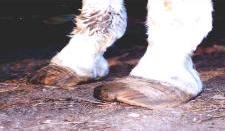
|
Photo no. 1 was actually taken after 2 trims at weekly intervals. Before trimming began, his toe was 5 cms longer than pictured here. Already at the time of this first photo his comfort levels had improved so much he was cantering around the paddock again.
Even though the horse was obviously feeling better than he had in a very long time he still had a long way to go.
Regular weekly trims then became fortnightly and eventually monthly. A Hoof that is this deformed will continue to grow in an unbalanced manner if it is not receiving regular trims that address excess growth.
By trimming regularly unnatural lever forces are minimized ensuring the new hoof
is growing down with good attachment to the coffin bone, encouraging the return of hoof mechanism and healing.
Photo no 2.
Nibby, December 2002.
A tighter connection growing down.
|
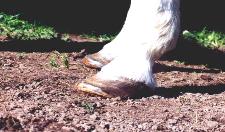
|
The reason the process can be a lengthy one when trying to heal damaged hooves is that you have to wait for the horse to grow a completely new hoof from the coronet to the ground which can take from 9 months to 1 year.
With the degree of damage that has occurred in this particular horse it could be take as many as 3 full hoof growths before he will be completely sound again and possibly even able to be ridden.
Photo no 3.
Nibby, February 2003.
Ten months after 1st trim, old hoof nearly at
ground level.
|
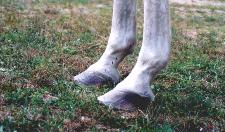
|
Photo no. 3 was taken 10 months after his trimming began and while there is now a far better connection between the coffin bone and hoof wall he still needs to regain more concavity underneath the hoof. Even so, considering his soles were actually convex when his trims began he has already come a long way. Provided this old horse lives long enough he will one day have great hooves again.
Importance of Natural Management
The management changes that are necessary for ridden Barefoot or Naturally Trimmed horses are even more important with Laminitic horses. Movement, the company of other horses, soaking of hooves in dry weather and natural feeding practises, plus extra attention to what the horse is eating can all help to create a positive outcome when dealing with Founder.
Recent research has shown that Alfalfa-Lucerne, clover, Birdsfoot Trefoil and Crownvetch can be founder triggers.
Safe grasses to feed are Timothy, Orchardgrass and Bromegrass.
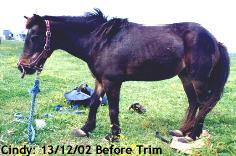
A Case Study - Cindy
Cindy, a small pony, was about to be put on the meat truck. She was in extreme discomfort before her first Natural Hoof Trim and was spending most of her time either lying down or in the classic 'founder stance'. Her accelerated heart rate was an obvious indication of the stress she was suffering from. The owner was quite happy for the pony to be removed for rehabilitation.
Hoof imbalance over a long period of time causes joint and muscle
adaptations so Cindy's
trimming was again a
very gradual process.
Slowly removing the
excess hoof with weekly
trims. Allowing her
time to readjust
throughout her body to
the increasing hoof
balance. She was also
gently hand led daily
with protective boots
on her feet.
Cindy's Natural Treatment
The daily walks helped encourage blood flow and healing. Attention was also paid to her diet, mineral deficiency and pain levels.
Though she was never given Bute she did have Natural pain relief in the first
few days.
She was also given daily hoof soaking, 10 minutes a day with water up to the coronet level. This helps maintain the elasticity of the hoof capsule, which is needed for hoof mechanism.
Her comfort levels improved dramatically and 1 week after her first trim she
wanted to trot when led out.
Her progress continued at a tremendous rate and 12
days after beginning her rehabilitation she was galloping and bucking around the
paddock and was even able to give her new 7 year old owner a short ride around
the lawn.

The above photos were taken 2 months after her trimming began. With careful and
gradual Natural Hoof Trimming she has regained some hoof balance, which has
allowed her tendons, ligaments, muscles and joints to slowly readjust to a more
natural alignment ensuring comfort throughout her body.
By paying attention to each horses individual healing process, hoof balance and
health is brought about at the pace the horse dictates which allows each horse
the time it needs to heal in its own unique way, whether that is 2 months or 2
years.
Special thanks has to go to Marjorie Smith for her information packed website www.barefoothorse.com. The wonderful knowledge gained from this website has helped make the recovery of these and hundreds of other Kiwi horses possible.
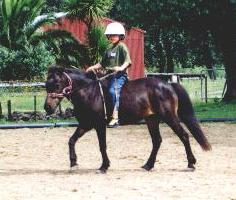
Ahren and Cindy one month after her trimming began.
Submit an Article or Case Study
The more we share information, the better off our
horses are going to be. If you'd like to share your
story, please email the
editor.
Disclaimer: Natural Hoof
reserves the right to change or edit any part of
all articles and case studies submitted to this
website. Natural Hoof does not take any
responsibility for the content of any articles
and/or case studies and/or any misapplication of the information presented in any articles. Natural Hoof presumes readers consult a professional for more information about any topic covered in any Natural Hoof article.
Home | Articles | Study Groups | Clinics-Events | Brag | Classifieds |
Order | Links


|
|









